 |
||
|
||
| ||
Gainward Bliss GeForce 8800 GT Golden Sample 1024MB PCI-E, Galaxy GeForce 8800 GT 512MB PCI-E, Gigabyte GeForce 8800 GT Zalman Edition 512MB PCI-E, Leadtek GeForce 8800 GT ZL 512MB PCI-E, MSI GeForce 8800 GTS OC 512MB PCI-E, Palit GeForce 8800 GT Sonic 512MB PCI-E |
|||||||||||||||||||||||||||||||||||||||||||||||||||||||||||||||||||||||||||||||||||||||||||
| ASUS GeForce 8800 GT TOP 512MB PCI-E MSI GeForce 8800 GTS OC 512MB PCI-E Galaxy GeForce 8800 GT 512MB PCI-E Palit GeForce 8800 GT Sonic 512MB PCI-E |
|
| Each graphics card has 512 MB of GDDR3 SDRAM allocated in eight chips on the front side of the PCB.
Samsung memory chips (GDDR3). 1.0 ns memory access time, which corresponds to 1000 (2000) MHz. |
 |
|
Gigabyte GeForce 8800 GT Zalman Edition 512MB PCI-E Leadtek GeForce 8800 GT ZL 512MB PCI-E |
|
| Each graphics card has 512 MB of GDDR3 SDRAM allocated in eight chips on the front side of the PCB.
Qimonda memory chips (GDDR3). 1.0 ns memory access time, which corresponds to 1000 (2000) MHz. |
 |
| Gainward Bliss GeForce 8800 GT Golden Sample 1024MB PCI-E | |
| The graphics card has 1024 MB of GDDR3 SDRAM allocated in sixteen chips on the front and back sides of the PCB.
Samsung memory chips (GDDR3). 1.0 ns memory access time, which corresponds to 1000 (2000) MHz. |
 |
| Comparison with the reference design, front view | |
|
Gainward Bliss GeForce 8800 GT Golden Sample 1024MB PCI-E
|
Reference card NVIDIA GeForce 8800 GT
|
|
Gigabyte GeForce 8800 GT Zalman Edition 512MB PCI-E
|
|
|
ASUS GeForce 8800 GT TOP 512MB PCI-E
|
|
|
Galaxy GeForce 8800 GT 512MB PCI-E
|
|
|
Palit GeForce 8800 GT Sonic 512MB PCI-E
|
|
|
Leadtek GeForce 8800 GT ZL 512MB PCI-E
|
|
|
MSI GeForce 8800 GTS OC 512MB PCI-E
|
Reference card NVIDIA GeForce 8800 GTS 512
|
| Comparison with the reference design, back view | |
|
Gainward Bliss GeForce 8800 GT Golden Sample 1024MB PCI-E
|
Reference card NVIDIA GeForce 8800 GT
|
|
Gigabyte GeForce 8800 GT Zalman Edition 512MB PCI-E
|
|
|
ASUS GeForce 8800 GT TOP 512MB PCI-E
|
|
|
Galaxy GeForce 8800 GT 512MB PCI-E
|
|
|
Palit GeForce 8800 GT Sonic 512MB PCI-E
|
|
|
Leadtek GeForce 8800 GT ZL 512MB PCI-E
|
|
|
MSI GeForce 8800 GTS OC 512MB PCI-E
|
Reference card NVIDIA GeForce 8800 GTS 512
|
ASUS, Leadtek, and MSI products are actually reference cards, only the Leadtek card has a different cooler.
The other cards have been tampered with by their manufacturers. The Galaxy card has a unique design, it's equipped with a jumper to increase the core voltage, which raises the overclocking potential of the card. Cards from Leadtek, Gigabyte, Gainward, Palit are equipped with unique cooling systems. The Gainward product also features a gigabyte of video memory, which affected its PCB layout.
All cards have TV-Out with a unique jack. You will need a special bundled adapter to output video to a TV-set via S-Video or RCA. You can read about the TV-Out in more detail here.
Analog monitors with d-Sub (VGA) interface are connected with special DVI-to-d-Sub adapters. The bundle also includes DVI-to-HDMI adapters (these graphics cards support video/audio transfer to HDMI receivers), so there should be no problems with such monitors. Maximum resolutions and frequencies:
What concerns MPEG2 playback features (DVD-Video), we analyzed this issue in 2002. Little has changed since that time. CPU load during video playback on modern graphics cards does not exceed 25%.
What concerns HDTV. You can read one review here.
All these cards require additional power supply, so each card is bundled with an adapter from molex to 6-pin, even though all modern PSUs are equipped with these cables. I want to note that the card from Galaxy has TWO power connectors for higher stability in the overclocked mode.
Now about the cooling systems. I shall not describe coolers of the reference 8800 GT/GTS cards (MSI, ASUS), because we have already examined them.
The Gigabyte card is equipped with the standard cooling system from Zalman, we already examined it. The same concerns the cooler from Palit.
We monitored temperatures using RivaTuner (written by A.Nikolaychuk AKA Unwinder). Here are the results:
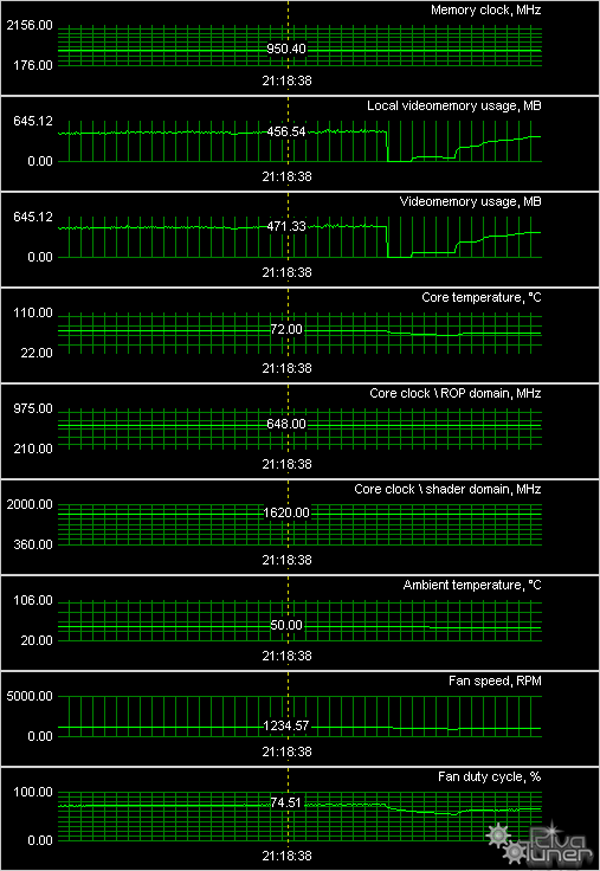
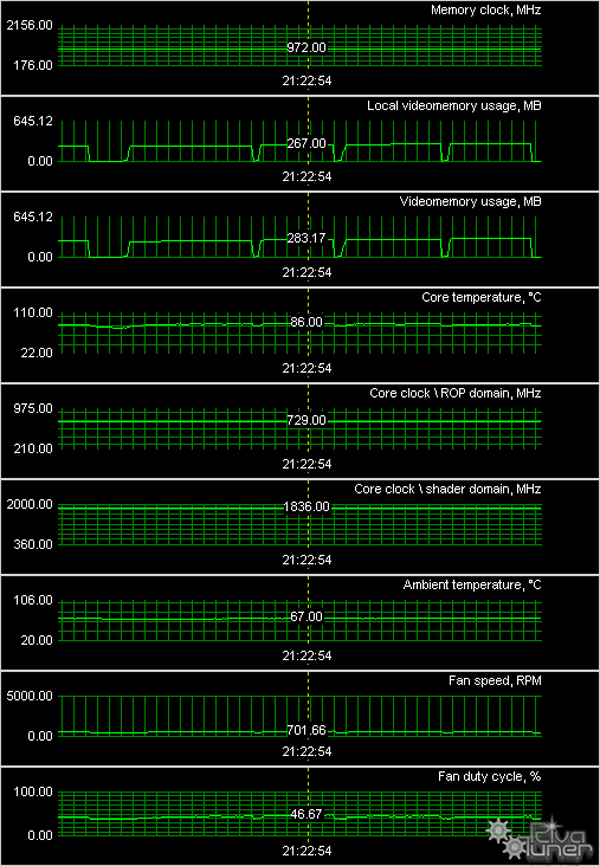

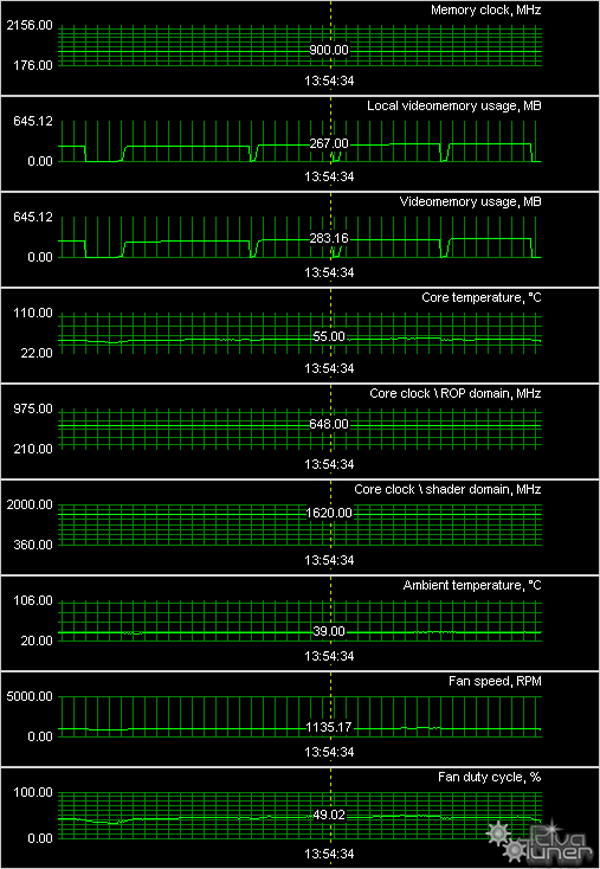
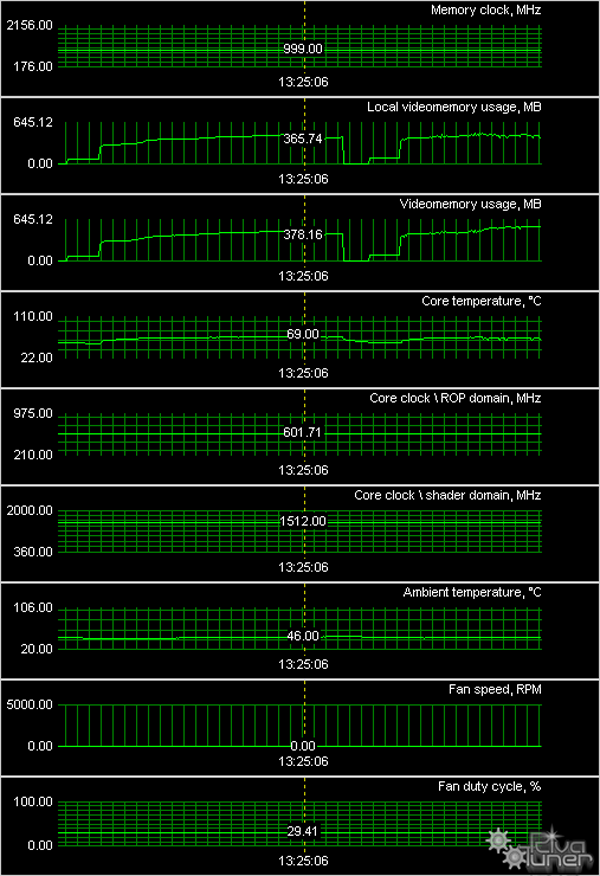
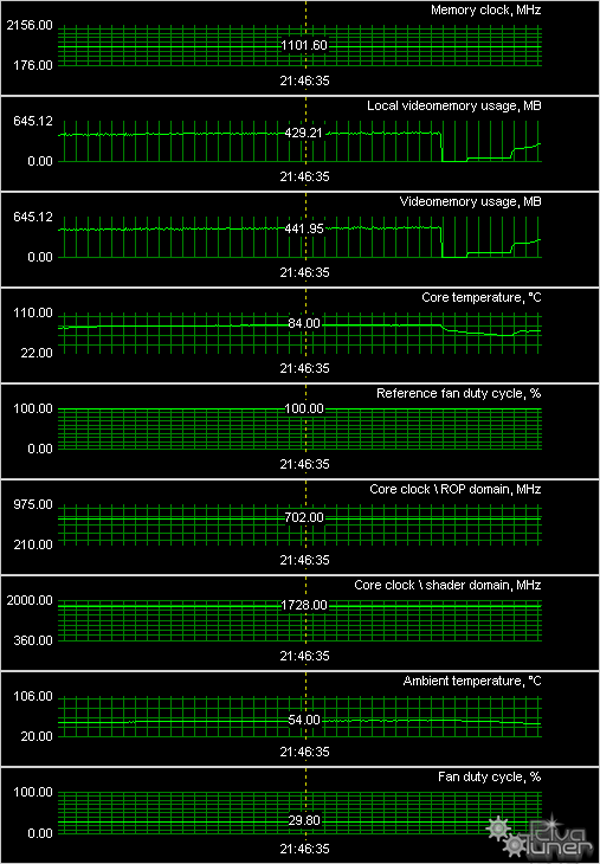
We can see that the most efficient and noiseless cooling system is the device on the Leadtek card. The other coolers provide more or less sufficient cooling for the GPU and memory chips. The hottest cooling system is expectedly the device on the MSI GeForce 8800 GTS. We should take into account that all heat release parameters were measured in a closed PC case with a good ventilation system (two intake coolers and two eject coolers).
We do not publish monitoring results of the cards from ASUS and Palit, because their temperature readings do not differ much from the reference systems, and we already monitored such cards before. Even though Palit installs its own cooler, its efficiency is practically on a par with the reference cooler, but it's not noisy.
We got our card from Gigabyte without a package and bundle, so we have nothing to describe here.
The other cards were bundled with a User Manual, CD with drivers and utilities, a DVI-to-VGA adapter, a component output adapter (TV-Out), an external power adapter. It's a basic bundle. And now let's see what other accessories are added by each vendor.
Testbed configuration:
We used the following test applications:
If you have a decent understanding of 3D graphics, you may draw your own conclusions for the charts below. However, if you are interested in our comments on test results, you may read them after each test. Anything that is important to beginners and those who are new to the world of graphics cards will be explained in detail in the comments.
First of all, you should look through our reference materials on modern graphics cards and their GPUs. Be sure to note the operating frequencies, support for modern technologies (shaders), as well as the pipeline architecture.
ATI RADEON X1300-1600-1800-1900 Reference
NVIDIA GeForce 7300-7600-7800-7900 Reference
If you have just begun realizing how large the selection to choose a graphics card is, don't worry, our 3D Graphics section offers articles about 3D basics (you will still have to understand them—when you run a game and open its options, you'll see such notions as textures, lighting, etc.) as well as new product reviews. We also publish monthly i3DSpeed that sums up all comparisons of graphics cards for various price ranges.
Thirdly, have a look at the test results. We are not going to analyze each test in this article, primarily because for us it makes sense to draw a general bottom line in the end. We will, however, make sure that we make our readers aware of anything unusual.
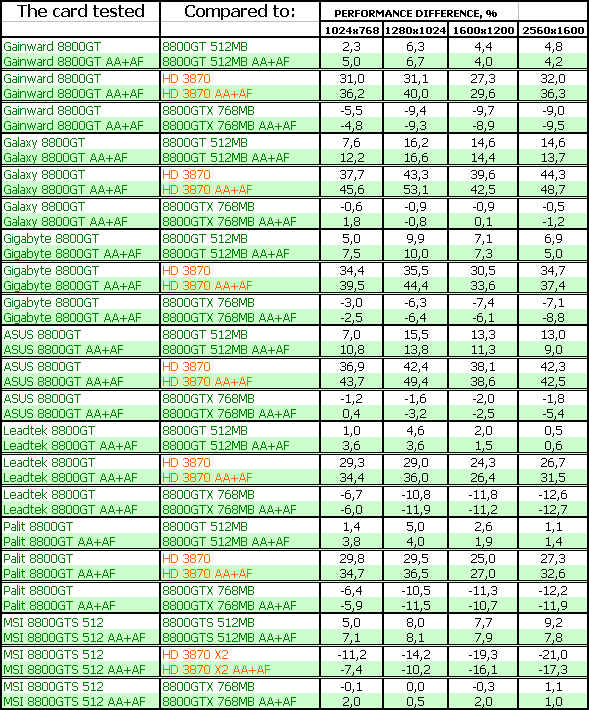
Test results: CRYSIS, Rescue, DX9, High
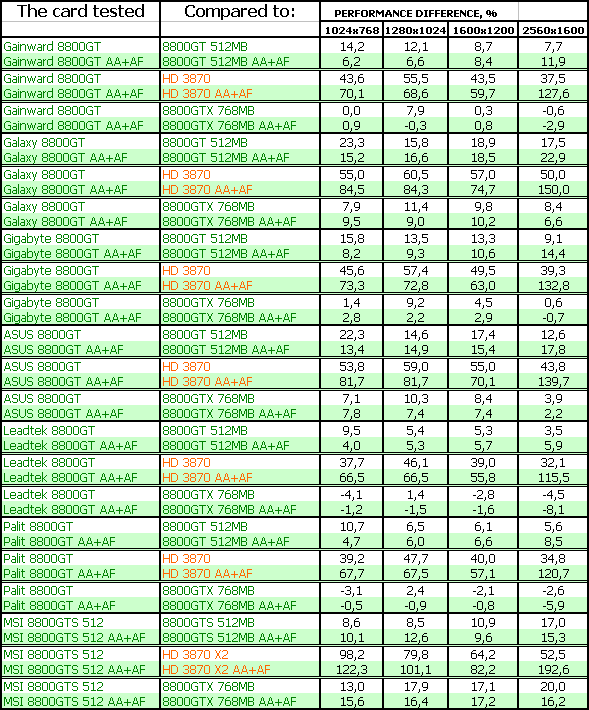
Test results: CRYSIS, Harbor, DX9, High

Test results: CRYSIS, Rescue, DX10, Very High
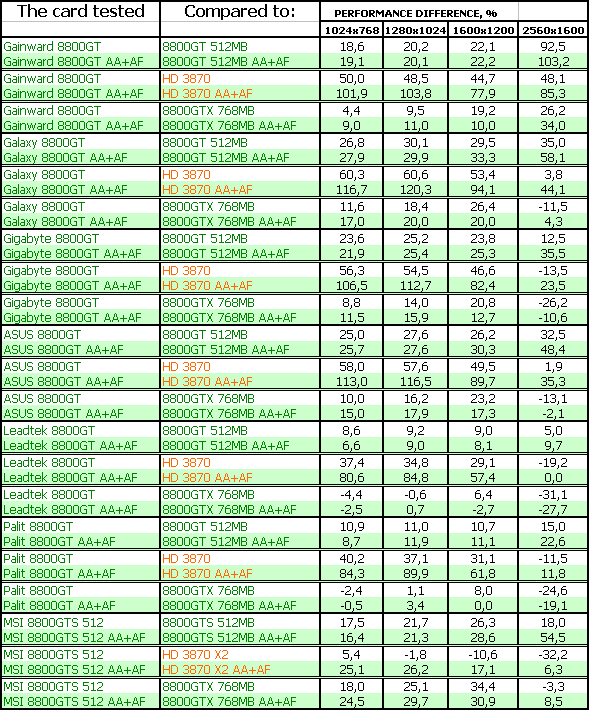
Test results: CRYSIS, Harbor, DX10, Very High

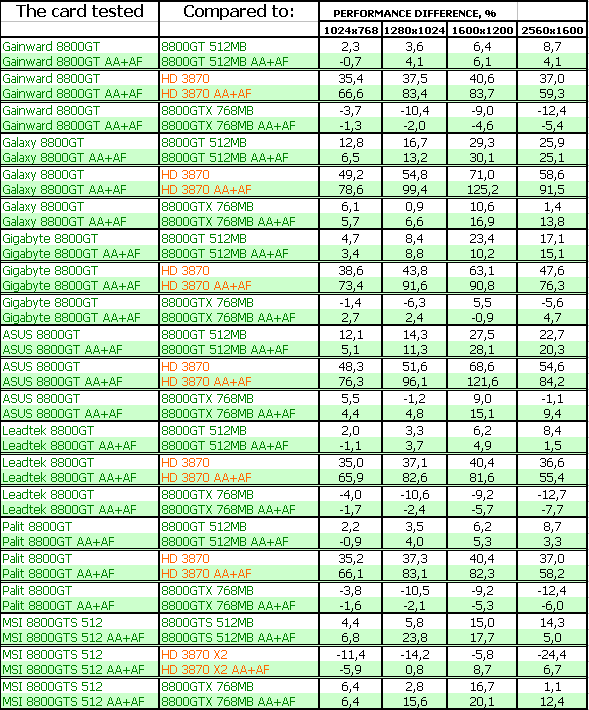

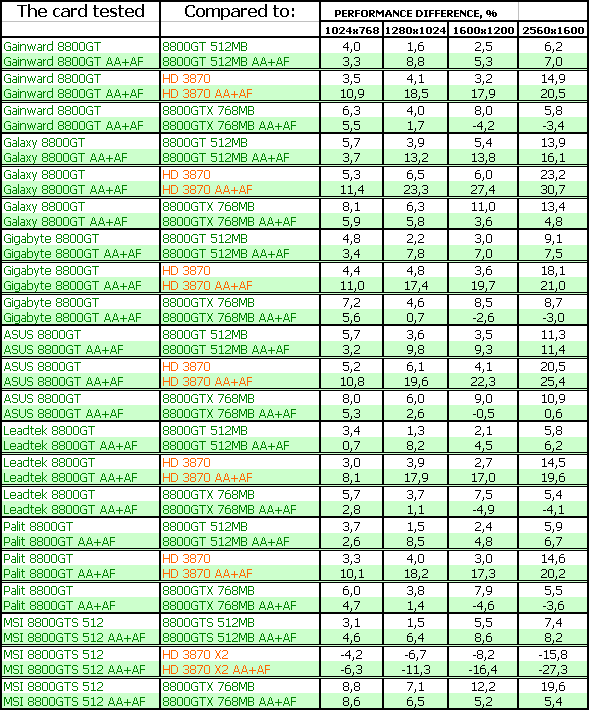
Test results: 3DMark06 SM2.0 MARKS

Test results: 3DMark06 SM3.0 MARKS

Our test results have proved that most 8800 GT cards reviewed today do not differ much from each other in performance. However, the overclocked products demonstrate very good results in CRYSIS, our current reference for 3D performance. These cards are even faster than the more expensive 8800 GTX in a number of tests. All 8800 GT cards heavily outperform the RADEON HD 3870.
ASUS GeForce 8800 GT TOP 512MB PCI-E is a reference card operating at increased frequencies. So it features all problems of the reference cooler: noise and mediocre cooling efficiency. A special note to fans of this brand: ASUS has nothing to do with its manufacturing, it's manufactured at a third-party plant by NVIDIA's orders, like all reference cards. It has a bonus in the bundle—a modern game and a leather CD album.
Gainward Bliss GeForce 8800 GT Golden Sample 1024MB PCI-E is not a standard solution. It has twice as much memory, and it operates at increased frequencies. Our tests demonstrate that CRYSIS responds well to the increased memory volume, although it does not need 1 GB of video memory in a general case. The best memory size for top graphics cards is 768 MB, like in the 8800 GTX. However, time flies, games demand more and more resources, and NVIDIA has abandoned the architecture with a 384-bit bus and 768 MB of memory, so we can have only 1 GB. It may soon become a new standard for top graphics cards. On the whole, the card from Gainward produces a very good impression.
MSI GeForce 8800 GTS OC 512MB PCI-E is a reference card. Like ASUS, MSI does not manufacture these graphics cards on its own, it just buys ready cards from NVIDIA. So it's a usual reference card. The cooler is quiet, but the card gets very hot. However, hot air is thrown out of a PC case, so there is nothing to worry about. This product is the fastest card of all modern graphics cards. No other card can outperform it, because the 8800 Ultra/GTX is already discontinued.
Galaxy GeForce 8800 GT 512MB PCI-E is an interesting product. However, it combines a lot of pros and cons. Advantages of the card are quite clear—it's a graphics card for overclockers. I've also published test results of this card operating at increased frequencies (I used the jumper to raise the core voltage.) Besides, such cards are bundled with coolers from Zalman (according to Galaxy web site). A manager from this company assured us that such a noisy cooler was installed on our sample by mistake. The cooler is indeed very noisy. Unfortunately, external power connectors on the card are very close to each other, and manufacturers didn't take into account that such connectors in PSU cables may be too thick to plug two of them at once. You will have to use adapters. And the main problem: we couldn't show our readers the true temperature readings of the overclocked card with the "correct" stock cooler.
Palit GeForce 8800 GT Sonic 512MB PCI-E is not a reference card, Palit has traditionally modified the PCB layout. The card is equipped with an efficient cooling system. It's a two-slot device, but it's not a problem these days. The graphics card operates at increased frequencies. However, the manufacturer should have overclocked it a tad higher—this card would have become a very interesting offer in this case. Still, it's a very good card as it is. The manufacturer should stop using the same box with different labels for all products. Real brands make good boxes for each type of graphics cards.
Gigabyte GeForce 8800 GT Zalman Edition 512MB PCI-E is manufactured by Gigabyte, although it's a copy of the reference design. An efficient and quiet cooling system from Zalman allows to overclock the card without overheating problems. As we didn't got the box with bundled components for this card, we cannot evaluate them.
Leadtek GeForce 8800 GT ZL 512MB PCI-E is a reference card again, but it's equipped with an efficient and quiet cooler from Zalman. It's an overclocked card, but this product operates at the lowest temperatures among our today's cards. This is a very good point.
As always, the final choice is up to the reader. We can only inform you about products and their performance, but can't make a buying decision.
And another thing that we are not tired to repeat from article to article. Having decided to choose a graphics card by yourself, you have to realize you're to change one of the fundamental PC parts, which might require additional tuning to improve performance or enable some qualitative features. This is not a finished product, but a component part. So, you must understand that in order to get the most from a new graphics card, you will have to acquire some basic knowledge of 3D graphics and graphics in general. If you are not ready for this, you should not perform upgrades by yourself. In this case it would be better to purchase a ready chassis with preset software (along with vendor's technical support,) or a gaming console that doesn't require any adjustments.
To find more information regarding the current graphics card market and the performance of various cards, feel free to read our monthly special i3DSpeed.
Gainward Bliss GeForce 8800 GT Golden Sample 1024MB PCI-E, Palit GeForce 8800 GT Sonic 512MB PCI-E, Gigabyte GeForce 8800 GT Zalman Edition 512MB PCI-E, Leadtek GeForce 8800 GT ZL 512MB PCI-E get the Original Design award (February):

ASUS GeForce 8800 GT TOP 512MB PCI-E gets the Excellent Package award (February):

Write a comment below. No registration needed!
|
Article navigation: |
| blog comments powered by Disqus |
| Most Popular Reviews | More RSS |
 |
Comparing old, cheap solutions from AMD with new, budget offerings from Intel.
February 1, 2013 · Processor Roundups |
 |
Inno3D GeForce GTX 670 iChill, Inno3D GeForce GTX 660 Ti Graphics Cards A couple of mid-range adapters with original cooling systems.
January 30, 2013 · Video cards: NVIDIA GPUs |
 |
Creative Sound Blaster X-Fi Surround 5.1 An external X-Fi solution in tests.
September 9, 2008 · Sound Cards |
 |
The first worthwhile Piledriver CPU.
September 11, 2012 · Processors: AMD |
 |
Consumed Power, Energy Consumption: Ivy Bridge vs. Sandy Bridge Trying out the new method.
September 18, 2012 · Processors: Intel |
| Latest Reviews | More RSS |
 |
Retested all graphics cards with the new drivers.
Oct 18, 2013 · 3Digests
|
 |
Added new benchmarks: BioShock Infinite and Metro: Last Light.
Sep 06, 2013 · 3Digests
|
 |
Added the test results of NVIDIA GeForce GTX 760 and AMD Radeon HD 7730.
Aug 05, 2013 · 3Digests
|
 |
Gainward GeForce GTX 650 Ti BOOST 2GB Golden Sample Graphics Card An excellent hybrid of GeForce GTX 650 Ti and GeForce GTX 660.
Jun 24, 2013 · Video cards: NVIDIA GPUs
|
 |
Added the test results of NVIDIA GeForce GTX 770/780.
Jun 03, 2013 · 3Digests
|
| Latest News | More RSS |
Platform · Video · Multimedia · Mobile · Other || About us & Privacy policy · Twitter · Facebook
Copyright © Byrds Research & Publishing, Ltd., 1997–2011. All rights reserved.